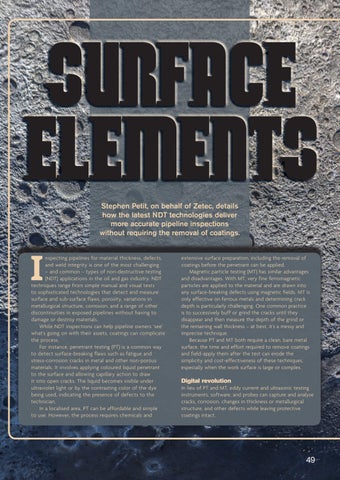Stephen Petit, on behalf of Zetec, details how the latest NDT technologies deliver more accurate pipeline inspections without requiring the removal of coatings.
I
nspecting pipelines for material thickness, defects, and weld integrity is one of the most challenging – and common – types of non-destructive testing (NDT) applications in the oil and gas industry. NDT techniques range from simple manual and visual tests to sophisticated technologies that detect and measure surface and sub-surface flaws, porosity, variations in metallurgical structure, corrosion, and a range of other discontinuities in exposed pipelines without having to damage or destroy materials. While NDT inspections can help pipeline owners ‘see’ what’s going on with their assets, coatings can complicate the process. For instance, penetrant testing (PT) is a common way to detect surface-breaking flaws such as fatigue and stress-corrosion cracks in metal and other non-porous materials. It involves applying coloured liquid penetrant to the surface and allowing capillary action to draw it into open cracks. The liquid becomes visible under ultraviolet light or by the contrasting color of the dye being used, indicating the presence of defects to the technician. In a localised area, PT can be affordable and simple to use. However, the process requires chemicals and
extensive surface preparation, including the removal of coatings before the penetrant can be applied. Magnetic particle testing (MT) has similar advantages and disadvantages. With MT, very fine ferromagnetic particles are applied to the material and are drawn into any surface-breaking defects using magnetic fields. MT is only effective on ferrous metals and determining crack depth is particularly challenging. One common practice is to successively buff or grind the cracks until they disappear and then measure the depth of the grind or the remaining wall thickness – at best, it’s a messy and imprecise technique. Because PT and MT both require a clean, bare metal surface, the time and effort required to remove coatings and field-apply them after the test can erode the simplicity and cost-effectiveness of these techniques, especially when the work surface is large or complex.
Digital revolution In lieu of PT and MT, eddy current and ultrasonic testing instruments, software, and probes can capture and analyse cracks, corrosion, changes in thickness or metallurgical structure, and other defects while leaving protective coatings intact.
49










